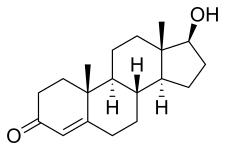
Back Androgeen Afrikaans أندروجين Arabic Андроген Bulgarian অ্যান্ড্রোজেন Bengali/Bangla Androgen BS Androgen Catalan ئەندرۆجین CKB Androgen Czech Androgen Danish Androgene German
| Androgen | |
|---|---|
| Drug class | |
 Testosterone, the major androgen | |
| Class identifiers | |
| Synonyms | Androgenic hormone; Testoid |
| Use | Hypogonadism, transgender men, performance enhancement, bodybuilding, others |
| ATC code | G03B |
| Biological target | Androgen receptor, mARs (e.g., GPRC6A, others) |
| External links | |
| MeSH | D000728 |
| Legal status | |
| In Wikidata | |
An androgen (from Greek andr-, the stem of the word meaning 'man') is any natural or synthetic steroid hormone that regulates the development and maintenance of male characteristics in vertebrates by binding to androgen receptors.[1][2] This includes the embryological development of the primary male sex organs, and the development of male secondary sex characteristics at puberty. Androgens are synthesized in the testes, the ovaries, and the adrenal glands.
Androgens increase in both males and females during puberty.[3] The major androgen in males is testosterone.[4] Dihydrotestosterone (DHT) and androstenedione are of equal importance in male development.[4] DHT in utero causes differentiation of the penis, scrotum and prostate. In adulthood, DHT contributes to balding, prostate growth, and sebaceous gland activity.
Although androgens are commonly thought of only as male sex hormones, females also have them, but at lower levels: they function in libido and sexual arousal. Androgens are the precursors to estrogens in both men and women.
In addition to their role as natural hormones, androgens are used as medications; for information on androgens as medications, see the androgen replacement therapy and anabolic steroid articles.
- ^ Moini J (2015). Fundamental Pharmacology for Pharmacy Technicians. Cengage Learning. p. 338. ISBN 978-1-30-568615-1.
Androgen is the generic term for any natural or synthetic compound, usually a steroid hormone, which stimulates or controls the development of masculine characteristics by binding to androgen receptors.
- ^ Gylys BA, Wedding ME (2017). Medical Terminology Systems: A Body Systems Approach. F.A. Davis. p. 82. ISBN 978-0-80-365868-4.
Generic term for an agent (usually a hormone, such as testosterone or androsterone) that stimulates development of male characteristics.
- ^ "15 Ways To Get Rid of Pimples Overnight Natural". Fast Health Fitness. 17 May 2016.
- ^ a b Carlson N (22 January 2012). Physiology of Behavior. Reproductive Behavior. Vol. 11th edition. Pearson. p. 326. ISBN 978-0205239399.